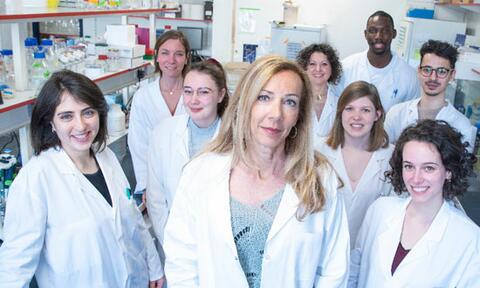
Development of an anti-sarcopenia treatment
The team headed by France Pietri-Rouxel at the Centre de recherche en Myologie has been awarded financial support from the Merck MSDAvenir foundation for its STRONG project in 2023.
France Pietri-Rouxel and her "DMD gene therapy & skeletal muscle pathophysiology" team study dystrophinopathies, which are myopathies caused by abnormalities in the DMD gene encoding a protein called dystrophin, and in particular Duchenne muscular dystrophy (DMD). The team is also studying a pathology of aging muscle: sarcopenia, one of the major concerns of the public health system. Sarcopenia is a complex age-related muscular disease that affects between 10% and 16% of people over the age of 65, and can eventually lead to a reduction of more than 30% in initial muscle mass. This disease leads to a general deterioration in physical condition, resulting in an increased risk of falls, longer hospital stays, loss of autonomy and, inevitably, higher morbidity and mortality rates.
With the aim of developing a treatment for sarcopenia, the team focused on the GDF5 (Growth Differentiation Factor 5) protein, which has been described as crucial for maintaining muscle mass in a situation where the muscle is no longer preserved. Indeed, under certain conditions, the muscle can lose mass - this is known as muscular atrophy - but the muscle does not disappear: it atrophies and then stabilizes. The team therefore sought to understand the mechanisms underlying this stabilization, because in the case of sarcopenia, there is an inescapable loss of muscle mass without this loss stabilizing. In the context of aging muscle, the STRONG project investigated the therapeutic potential of this protein in preserving muscle mass and strength in aged mice.
Using a viral vector, the researchers over-expressed GDF5 in the muscle of aged mice and showed that, following this over-expression, 42% of the genes deregulated during aging had normalized expression, identical to that observed in the muscle of young mice as if they had been rejuvenated. To develop a pharmacological treatment, the team chemically synthesized the human sequence of the modified GDF5 protein (hGDF5-P) to optimize its stability and efficacy on muscle mass and function. Treatment of aged mice with the GDF5 protein has been shown to counter age-related muscle loss, improve muscle function and ensure nerve-muscle connectivity. Furthermore, in human muscle biopsies, the team found the same age-related alterations as those observed in mice, suggesting that this treatment could be useful in humans to combat sarcopenia. Overall, these data provide a basis for examining the curative potential of the GDF5 drug in clinical trials for sarcopenia and, potentially, other neuromuscular diseases. This is one of the strategic projects supported by the Institute of Myology (AIM).
The STRONG project, financed by the Merck MSD/Avenir Foundation, includes studies of doses and routes of administration. These are expensive studies, and the substantial funding has enabled the molecule to be developed pre-clinically.
The routes of administration are currently intra-muscular and systemic, and the potential benefits or toxicity are being studied. If we can provide a treatment, we'll preserve muscle mass either in the treatment of sarcopenia to improve well-being, or in situations of immobilization or coma, for example.
GDF5 is a physiological, non-toxic protein. It is known to the body because, in certain circumstances, it is secreted to compensate for mass loss and stabilize muscle. However, in drug development, the study of effective dose is essential. The market for this potential drug is enormous, given the ageing of the population, with a forecast 20-32 million sarcopenics in Europe by 2045.
Three patents have been filed on this discovery. The first concerns the use of this molecule in all conditions of muscular atrophy: cancer, immobilization, coma, neuromuscular diseases. The second patent concerns the combination of GDF5 with another therapeutic strategy targeting neuromuscular diseases, and the third patent relates to an optimized GDF5 molecule.
